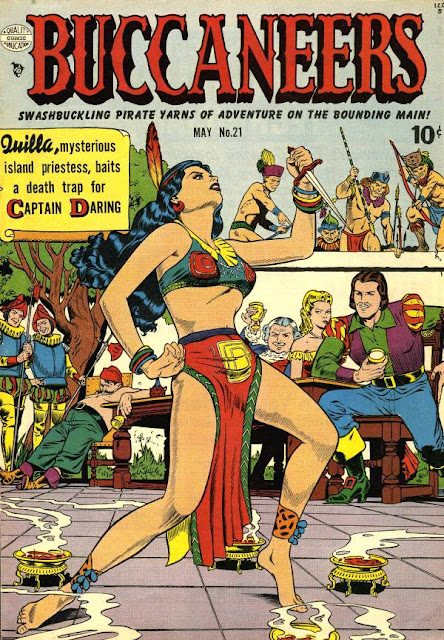We take this time out from our regularly scheduled Overlooked Film to celebrate a big day in
Black Mask history. Mysterious Press, in cooperation with Open Road Media and Keith Deutsch of Blackmaskmagazine.com, introduce a new line of eBooks featuring some of the best stories from the magazine.
The three books above feature one story apiece. They’re all great ones, and I’m pleased to see them back in print, but I'm most excited about the book below,
Jerry Tracy, Celebrity Reporter, by Theodore Tinsley. This massive eBook features 25 stories - the complete run of the series - and every tale is packed with wit and humor.
But first, the single-story books. Each is an outstanding example of
Black Mask storytelling, and each excels in a different way.
The style of Paul Cain’s “
Pigeon Blood” is nowhere near as tough as his iconic novel,
Fast One, but the protagonist, an extra-legal attorney named Druse, is as hardboiled as they come. This time, Druse’s case involves a string of pigeon blood rubies that may or may not be genuine, the attractive socialite who owns them, her stuffy husband, and a gambling hall owner with guns at his disposal. Druse turns them on their heads, grinds them up and delivers a solution he finds satisfactory - and lucrative - to himself.
“
Red Goose” is a fine example of the cockeyed humor routinely delivered by Norbert Davis. Hollywood gumshoe Ben Shaley has a put-upon personality much like that of Davis’s most famous detective - Doan, of the Doan & Carstairs books. In this, the first of two Shaley tales to appear in
Mask, he’s sent after a stolen painting of a goose, and barely comes away with his life - which is more than can be said for others involved in the affair.
Steve Fisher wrote the screenplay for my all-time favorite mystery film,
Lady in The Lake, and all of his work makes me sit up and take notice. He was at his best with first-person narration, and “
You’ll Always Remember Me” is a prime example. This story, a chilling look into the mind of a young sociopath, is more noir than hardboiled.
Now onto the main attraction,
Jerry Tracy, Celebrity Reporter . . .Prior to this, I knew Theodore Tinsley only as the author of several Shadow novels, written as “Maxwell Grant” while Walter Gibson was out to lunch. Though I have a few of his Jerry Tracy stories in
Black Mask, I'd never bothered to read one. This 25-story collection is a real eye-opener, revealing Tinsley to be an extremely gifted hardboiled storyteller - with a unique and quirky style.
Our hero, Jerry Tracy, is a smart-mouthed columnist who dishes the dirt on Broadway for his newspaper the
Daily Planet. Yep, the
Daily Planet, and this series began in October 1932, six years before the first appearance of Superman. (For the record, Supes first went to work for the
Daily Star, but the paper soon underwent a name change, and this while the Tracy series was still running in
Mask.)
Though the Jerry Tracy stories are told in third person, this is
extremely close third person, so we’re often privy to Tracy’s thoughts. It was a shocker for me to discover that Tracy’s thoughts read like a cross between the narration of Dan Turner and Daffy Dill. Now
that’s entertainment. Jerry Tracy displays his quirky personality in his spoken dialogue, too, addressing everyone as “Bum,” employing the universal greeting “Hawzit,” and being generally inventive with the English language.
As I mentioned, this began in 1932, a full year and a half before Robert Leslie Bellem introduced Turner in
Spicy Detective, and Richard Sale brought Daffy Dill to life in
Detective Fiction Weekly. I have to wonder if either of those writers were influenced by Tinsley.
The dialogue makes the stories fun, but it’s the stories themselves that pack the real punch. While Dan Turner's adventures are all style and no substance, these Tracy tales are the real deal, putting Tinsely almost on a parr with Richard Sale. I haven’t had time to read all the stories in this book, but the half-dozen I’ve finished have heart and meaning, and even manage to comment on the human condition. In mystery stories from the thirties, that’s saying a lot - even for stories that appeared in
Black Mask.
Jerry Tracy, Celebrity Reporter sells for slightly more or less than ten bucks, depending where you buy it. That may seem high for an eBook, but in this case it’s a bargain. If this were a print volume, it would run over 1000 pages, and this is quality stuff. The 25 stories are presented in chronological order, following Tracy’s eight-year run from start to finish. Outside of dishing out thousands for the original magazines, there’s no way we’d ever be able to read this stuff. And as a bonus, we're treated to an insightful overview of Tinsley's career by Boris Dralyuk. Thank you Mysterious Press, Open Road and Keith Deutsch!
As previously announced, these four volumes are only the kick-off. A new eBook will follow each month. I'm already looking forward to the next.
You'll find where-to-buy info
HERE.
All drawings and paintings from Black Mask Magazine are copyright © 1923 to 1953 by Keith Alan Deutsch as successor-in-interest, and conservator of all copyrights to the original publishers and copyright registrars: Pro-Distributors Publishing Company, Inc, and Popular Publications Inc. All copyrights © renewed 1951 to 1981.













































+1950+600.jpg)








































